The Great Allotment: Pullen Point's First Land Owners
Introduction, William Aspinwall, Edward Bates, William Brenton, Thomas Buttolph, Thomas Fayerweather, Edward Gibbons, Valentine Hill, Ralph Hudson, Thomas Matson, Elias Maverick, John Oliver, William Pierce, John Sanford, William Stitson, John Winthrop/Deane Winthrop
William Pierce |
William Pierce (Peirce, Pearce) took up residence in Boston in 1632. He was admitted to the Boston Church that same year, and in 1634 took the Freeman's Oath and was made a Selectman. William was a noted sea captain who had made numerous many trans-Atlantic voyages from England. In 1623 he sailed the "Anne" to the Plymouth Colony. In 1624 he captained the "Charity" bringing the first dairy cattle to New England.
In early 1630 he sailed the "Lyon" first to Penobscott, Me., and then is in Salem, Mass. when John Winthrop arrives later in 1630. By August of that year it becomes evident that the Colonists would run out of food that winter. William is sent him to Ireland for provisions. He arrived back in Boston in February just as food was running out. More trips back and forth to England followed in 1631, the last time by way of Virginia. In 1632 it was back to Virginia, but he wrecked there and didn't get back to England until 1633.
He booked passage to Boston later in 1633, and took with him his wife Bridget, and a son. William had joined the Boston Church in 1632, Bridget joined in 1634.
William was the Captain of two of the earliest ocean-going ships made in North America, the "Rebecca", made in Medford, Mass., and the "Desire", made in Marblehead, Mass.
William's allotment of land on Pullen Point is recorded as:
"Willyam Peirce, 100 Acrs of Upland and Marsh together: bounded towards the north and northwest by the said Allottments of Thomas Fayreweather and Thomas Buttalph, towards the East and south East by the sea shore, and towards the southwest by the said Allottment of the Governor."
In 1636 William captained the "Desire" bringing troops and supplies for the war with the Pequot Indians. Then in the following year, he traveled to the West Indies bringing Pequot prisoners to be sold as slaves. On the return trip, he brought back black Africans to be sold as slaves. This endeavor was a financial success and is noted as the beginning of the slave trade in New England. He also brought the first sweet potatoes to New England, and is credited as the first author of book in North America, a Marine Almanac printed and bound by Stephen Daye in 1639.
Pierce sailed again to the West Indies in 1641 bringing settlers to the Puritan Colony at Providence Island, Nicaragua. Unfortunately, the Spanish had recently overrun what they considered a haven for pirates. Pierce was killed when he sailed into a trap attempting to rescue fellow countryman.
The Pierce land on Pullen Point was sold by Pierce's widow to Deane Winthrop in 1647.
Selected Pierce descendants, locations, and objects of note:
- An Almanac for New England for the Year 1639 - "1639. 1st month. A printing house was begun at Cambridge by one Daye, at the charge of Mr Glover, who died on seas hitherward. The first thing which was printed was the freeman’s oath; the next was an almanack made for New England by Mr William Peirce Mariner; the next was the Psalms newly turned into metre.". - Internet Archive
- Pierce's Alley, Boston, Mass. - In 1639 it was "ordered that a passage of seven feet wide\ be taken out of Mr. Pierce's garden." The first one-way street in Boston, it also has been known as "Fitch's alley," "Davis alley," and "Flagg alley," and finally "Change Ave." Gone now, a walkway runs near the original location. - The Crooked & Narrow Streets of the Town of Boston 1630-1822,
Annie Haven Thwing, 1920, pg. 140, Internet Archive
| Selected William Pierce Descendants |
| William (b. 1590); m. Bridget ________ |
| William (d.1661); m. Esther Webb |
| William |
| Moses |
Captain William Pierce has been called by historians one of the "most influential citizens" of early colonial New England, a "distinguished shipmaster," someone who was "on intimate terms with [Governor William] Bradford and [Governor Edward] Winslow," a "tried and trusted friend of [Governor John] Winthrop," and despite all the information about his life and accomplishments, there is almost no information about his wife and descendants.
On the other hand, there is a considerable amount of information about descendants of other families named Pierce (Peirce, Pearse, Pers) who were in North America at that time, including another Captain William Pierce in Virginia. Other New England Pierce's include:
- Abraham - Plymouth Colony. A taxpayer in 1623 and a soldier under Captain Myles Standish in 1633.
- Daniel - A blacksmith, he arrived in 1634 and settled in Watertown, Mass.
- John - A weaver, he emigrated in 1637 settling in Watertown, Mass.
- John - A cooper, he settled in Dorchester, Mass. and took the Freeman's Oath in 1631
- Michael - Emigrated first to Hingham, Mass. in 1645, then relocated to Scituate, Mass. He was killed by Native Americas in 1676. There is a a memorial at the site called Nine Men's Misery (Wikipedia).
- Richard - Settled in Portsmouth, R.I.
- Robert - Arriving in 1630, he was one of the first settlers of Dorchester, Mass.
- Thomas - Emigrated in 1634, settling in Charlestown, Mass.
Two of the Pierces, Michael in Scituate and Richard in Dorchester, are often identified as brothers of William. A possible third brother was the John Peirce who received the first (and second) charter for the Pilgrim settlement in the New World, the "Peirce Patent of 1621" (the actual document is at the Pilgrim Hall Museum in Plymouth, Mass.). John Peirce earned a less than favorable reputation for his dealings with the Pilgrims, but except for bad weather and a leaky ship, Plymouth Plantation might now be called Peirce's Plantation (see Littlefield's book Early Boston Booksellers 1642-1711, pg. 38). Some records say this John Peirce never came to America, and despite having similar occupations, is not the John Pierce who settled in Watertown, Mass.
Pierce genealogy books:
- Peirce Genealogy: Being the Record of the Posterity of John Pers, an Early Inhabitant of Watertown, in New England, Frederick Clifton Pierce, 1880, Internet Archive
- Peirce Genealogy: Being the Record of the Posterity of Thomas Pierce, an Early Inhabitant of Charlestown, Frederick Clifton Pierce, 1882, Internet Archive
- Peirce Genealogy: Being the Record of the Posterity of Richard Pierce, an Early Inhabitant of Providence, in Rhode Island, Frederick Clifton Pierce, 1888, Internet Archive
- Pierce Genealogy being the Record of Posterity of Capt. Michael, John, and Captain Pierce - Frederick Clifton Pierce, 1889, Internet Archive
- Abraham Pierce - The New England Historical and Genealogical Register, Volume 6, 1852, pg. 277, Google ebook
- My Ancestors in America, Compiled, Printed and Published for Gratuitous Distribution Among Near Relatives - Wm. Blake Pierce, 1864, Internet Archive
- Pierce, Perce, Pears, Pearse, Peirce, Piers - The Pioneers of Massachusetts, a Descriptive List, Drawn From Records of the Colonies, Towns and Churches and other Contemporaneous Documents, Charles Henry Pope, 1900, pg. 360, Internet Archive
- Thirty-one Generations: A Thousand Years of Percys and Pierces 972-1969 - Barnard Ledward Colby, 1969, Chapter 7, pg. 13, Internet Archive
William Pierce Links
|
| |
|
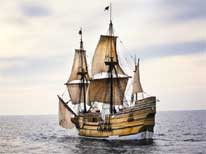 |
Mayflower II, William was captain of the "Anne" in 1623 bringing Pilgrims to the Plymouth Colony. In 1629 he sailed a second ship named "Mayflower" across the Atlantic - Plimoth Plantation |
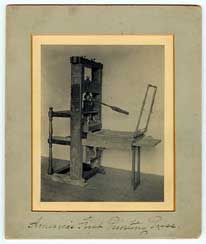 |
Stephen Daye's Printing Press (Cabridge, Mass.) (Internet Archive) Daye is considered the first printer in North America. The first thing he printed in 1639 was a Freeman's Oath, the second was an almanac for William - Cambridge Historical Society |
|
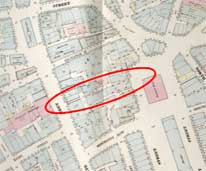 |
Pierce's Alley, Boston Mass. First one-way street in Boston was laid out in 1639. Renamed Change Ave. in this map. - 1867 Sanborn Fire Insurance Map from Boston, Mass., Library of Congress |
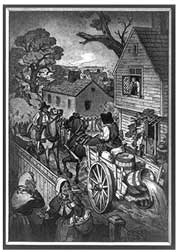 |
Pierce's Alley, running from State St. to Faneuil Hall Square, was only seven feet wide. It earned the colorful nickname "Damnation Alley". - First National Bank of Boston 1941 Calendar, Library of Congress |
| Other Pierces |
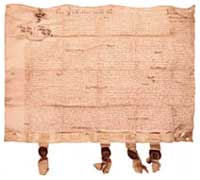 |
|
|
|
|
|
|